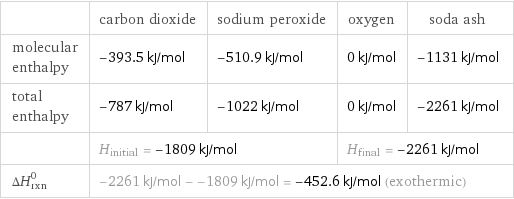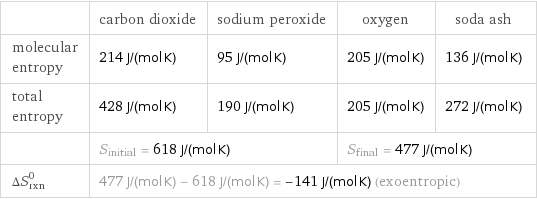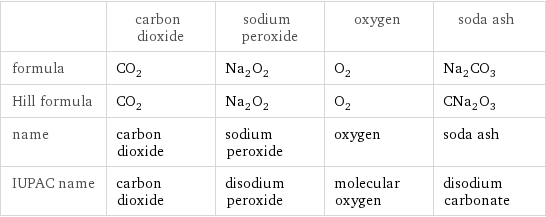Input interpretation

CO_2 (carbon dioxide) + Na_2O_2 (sodium peroxide) ⟶ O_2 (oxygen) + Na_2CO_3 (soda ash)
Balanced equation

Balance the chemical equation algebraically: CO_2 + Na_2O_2 ⟶ O_2 + Na_2CO_3 Add stoichiometric coefficients, c_i, to the reactants and products: c_1 CO_2 + c_2 Na_2O_2 ⟶ c_3 O_2 + c_4 Na_2CO_3 Set the number of atoms in the reactants equal to the number of atoms in the products for C, O and Na: C: | c_1 = c_4 O: | 2 c_1 + 2 c_2 = 2 c_3 + 3 c_4 Na: | 2 c_2 = 2 c_4 Since the coefficients are relative quantities and underdetermined, choose a coefficient to set arbitrarily. To keep the coefficients small, the arbitrary value is ordinarily one. For instance, set c_3 = 1 and solve the system of equations for the remaining coefficients: c_1 = 2 c_2 = 2 c_3 = 1 c_4 = 2 Substitute the coefficients into the chemical reaction to obtain the balanced equation: Answer: | | 2 CO_2 + 2 Na_2O_2 ⟶ O_2 + 2 Na_2CO_3
Structures

+ ⟶ +
Names

carbon dioxide + sodium peroxide ⟶ oxygen + soda ash
Reaction thermodynamics
Enthalpy

| carbon dioxide | sodium peroxide | oxygen | soda ash molecular enthalpy | -393.5 kJ/mol | -510.9 kJ/mol | 0 kJ/mol | -1131 kJ/mol total enthalpy | -787 kJ/mol | -1022 kJ/mol | 0 kJ/mol | -2261 kJ/mol | H_initial = -1809 kJ/mol | | H_final = -2261 kJ/mol | ΔH_rxn^0 | -2261 kJ/mol - -1809 kJ/mol = -452.6 kJ/mol (exothermic) | | |
Gibbs free energy

| carbon dioxide | sodium peroxide | oxygen | soda ash molecular free energy | -394.4 kJ/mol | -447.7 kJ/mol | 231.7 kJ/mol | -1044 kJ/mol total free energy | -788.8 kJ/mol | -895.4 kJ/mol | 231.7 kJ/mol | -2089 kJ/mol | G_initial = -1684 kJ/mol | | G_final = -1857 kJ/mol | ΔG_rxn^0 | -1857 kJ/mol - -1684 kJ/mol = -172.9 kJ/mol (exergonic) | | |
Entropy

| carbon dioxide | sodium peroxide | oxygen | soda ash molecular entropy | 214 J/(mol K) | 95 J/(mol K) | 205 J/(mol K) | 136 J/(mol K) total entropy | 428 J/(mol K) | 190 J/(mol K) | 205 J/(mol K) | 272 J/(mol K) | S_initial = 618 J/(mol K) | | S_final = 477 J/(mol K) | ΔS_rxn^0 | 477 J/(mol K) - 618 J/(mol K) = -141 J/(mol K) (exoentropic) | | |
Equilibrium constant
![Construct the equilibrium constant, K, expression for: CO_2 + Na_2O_2 ⟶ O_2 + Na_2CO_3 Plan: • Balance the chemical equation. • Determine the stoichiometric numbers. • Assemble the activity expression for each chemical species. • Use the activity expressions to build the equilibrium constant expression. Write the balanced chemical equation: 2 CO_2 + 2 Na_2O_2 ⟶ O_2 + 2 Na_2CO_3 Assign stoichiometric numbers, ν_i, using the stoichiometric coefficients, c_i, from the balanced chemical equation in the following manner: ν_i = -c_i for reactants and ν_i = c_i for products: chemical species | c_i | ν_i CO_2 | 2 | -2 Na_2O_2 | 2 | -2 O_2 | 1 | 1 Na_2CO_3 | 2 | 2 Assemble the activity expressions accounting for the state of matter and ν_i: chemical species | c_i | ν_i | activity expression CO_2 | 2 | -2 | ([CO2])^(-2) Na_2O_2 | 2 | -2 | ([Na2O2])^(-2) O_2 | 1 | 1 | [O2] Na_2CO_3 | 2 | 2 | ([Na2CO3])^2 The equilibrium constant symbol in the concentration basis is: K_c Mulitply the activity expressions to arrive at the K_c expression: Answer: | | K_c = ([CO2])^(-2) ([Na2O2])^(-2) [O2] ([Na2CO3])^2 = ([O2] ([Na2CO3])^2)/(([CO2])^2 ([Na2O2])^2)](../image_source/03465343b6bbc376259454e095122a12.png)
Construct the equilibrium constant, K, expression for: CO_2 + Na_2O_2 ⟶ O_2 + Na_2CO_3 Plan: • Balance the chemical equation. • Determine the stoichiometric numbers. • Assemble the activity expression for each chemical species. • Use the activity expressions to build the equilibrium constant expression. Write the balanced chemical equation: 2 CO_2 + 2 Na_2O_2 ⟶ O_2 + 2 Na_2CO_3 Assign stoichiometric numbers, ν_i, using the stoichiometric coefficients, c_i, from the balanced chemical equation in the following manner: ν_i = -c_i for reactants and ν_i = c_i for products: chemical species | c_i | ν_i CO_2 | 2 | -2 Na_2O_2 | 2 | -2 O_2 | 1 | 1 Na_2CO_3 | 2 | 2 Assemble the activity expressions accounting for the state of matter and ν_i: chemical species | c_i | ν_i | activity expression CO_2 | 2 | -2 | ([CO2])^(-2) Na_2O_2 | 2 | -2 | ([Na2O2])^(-2) O_2 | 1 | 1 | [O2] Na_2CO_3 | 2 | 2 | ([Na2CO3])^2 The equilibrium constant symbol in the concentration basis is: K_c Mulitply the activity expressions to arrive at the K_c expression: Answer: | | K_c = ([CO2])^(-2) ([Na2O2])^(-2) [O2] ([Na2CO3])^2 = ([O2] ([Na2CO3])^2)/(([CO2])^2 ([Na2O2])^2)
Rate of reaction
![Construct the rate of reaction expression for: CO_2 + Na_2O_2 ⟶ O_2 + Na_2CO_3 Plan: • Balance the chemical equation. • Determine the stoichiometric numbers. • Assemble the rate term for each chemical species. • Write the rate of reaction expression. Write the balanced chemical equation: 2 CO_2 + 2 Na_2O_2 ⟶ O_2 + 2 Na_2CO_3 Assign stoichiometric numbers, ν_i, using the stoichiometric coefficients, c_i, from the balanced chemical equation in the following manner: ν_i = -c_i for reactants and ν_i = c_i for products: chemical species | c_i | ν_i CO_2 | 2 | -2 Na_2O_2 | 2 | -2 O_2 | 1 | 1 Na_2CO_3 | 2 | 2 The rate term for each chemical species, B_i, is 1/ν_i(Δ[B_i])/(Δt) where [B_i] is the amount concentration and t is time: chemical species | c_i | ν_i | rate term CO_2 | 2 | -2 | -1/2 (Δ[CO2])/(Δt) Na_2O_2 | 2 | -2 | -1/2 (Δ[Na2O2])/(Δt) O_2 | 1 | 1 | (Δ[O2])/(Δt) Na_2CO_3 | 2 | 2 | 1/2 (Δ[Na2CO3])/(Δt) (for infinitesimal rate of change, replace Δ with d) Set the rate terms equal to each other to arrive at the rate expression: Answer: | | rate = -1/2 (Δ[CO2])/(Δt) = -1/2 (Δ[Na2O2])/(Δt) = (Δ[O2])/(Δt) = 1/2 (Δ[Na2CO3])/(Δt) (assuming constant volume and no accumulation of intermediates or side products)](../image_source/d789030dc13cf27045ee94920df93f11.png)
Construct the rate of reaction expression for: CO_2 + Na_2O_2 ⟶ O_2 + Na_2CO_3 Plan: • Balance the chemical equation. • Determine the stoichiometric numbers. • Assemble the rate term for each chemical species. • Write the rate of reaction expression. Write the balanced chemical equation: 2 CO_2 + 2 Na_2O_2 ⟶ O_2 + 2 Na_2CO_3 Assign stoichiometric numbers, ν_i, using the stoichiometric coefficients, c_i, from the balanced chemical equation in the following manner: ν_i = -c_i for reactants and ν_i = c_i for products: chemical species | c_i | ν_i CO_2 | 2 | -2 Na_2O_2 | 2 | -2 O_2 | 1 | 1 Na_2CO_3 | 2 | 2 The rate term for each chemical species, B_i, is 1/ν_i(Δ[B_i])/(Δt) where [B_i] is the amount concentration and t is time: chemical species | c_i | ν_i | rate term CO_2 | 2 | -2 | -1/2 (Δ[CO2])/(Δt) Na_2O_2 | 2 | -2 | -1/2 (Δ[Na2O2])/(Δt) O_2 | 1 | 1 | (Δ[O2])/(Δt) Na_2CO_3 | 2 | 2 | 1/2 (Δ[Na2CO3])/(Δt) (for infinitesimal rate of change, replace Δ with d) Set the rate terms equal to each other to arrive at the rate expression: Answer: | | rate = -1/2 (Δ[CO2])/(Δt) = -1/2 (Δ[Na2O2])/(Δt) = (Δ[O2])/(Δt) = 1/2 (Δ[Na2CO3])/(Δt) (assuming constant volume and no accumulation of intermediates or side products)
Chemical names and formulas

| carbon dioxide | sodium peroxide | oxygen | soda ash formula | CO_2 | Na_2O_2 | O_2 | Na_2CO_3 Hill formula | CO_2 | Na_2O_2 | O_2 | CNa_2O_3 name | carbon dioxide | sodium peroxide | oxygen | soda ash IUPAC name | carbon dioxide | disodium peroxide | molecular oxygen | disodium carbonate
Substance properties

| carbon dioxide | sodium peroxide | oxygen | soda ash molar mass | 44.009 g/mol | 77.978 g/mol | 31.998 g/mol | 105.99 g/mol phase | gas (at STP) | solid (at STP) | gas (at STP) | solid (at STP) melting point | -56.56 °C (at triple point) | 660 °C | -218 °C | 851 °C boiling point | -78.5 °C (at sublimation point) | | -183 °C | 1600 °C density | 0.00184212 g/cm^3 (at 20 °C) | 2.805 g/cm^3 | 0.001429 g/cm^3 (at 0 °C) | solubility in water | | reacts | | soluble surface tension | | | 0.01347 N/m | dynamic viscosity | 1.491×10^-5 Pa s (at 25 °C) | | 2.055×10^-5 Pa s (at 25 °C) | 0.00355 Pa s (at 900 °C) odor | odorless | | odorless |
Units
